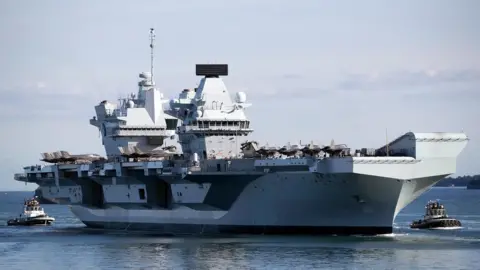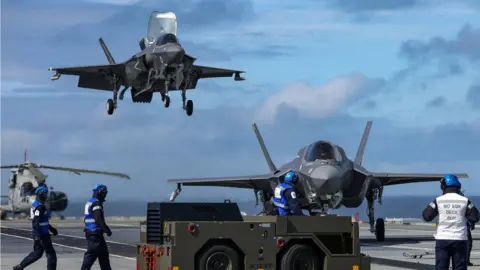HMS Queen Elizabeth: Why is a UK aircraft carrier going on a world tour?
 PA Media
PA MediaBritain is about to embark on a world tour - in the shape of the Royal Navy's aircraft carrier HMS Queen Elizabeth, accompanied by a fleet of warships.
The Royal Navy says it will be the most powerful UK naval deployment in a generation.
The government sees the fleet, named the Carrier Strike Group, as a potent symbol of "Global Britain" - and as proof of Boris Johnson's promise to restore the Royal Navy as Europe's foremost naval power and end what he called an "era of retreat".
The prime minister spent this morning on board HMS Queen Elizabeth in Portsmouth naval base, ahead of its maiden operational deployment.
But is this world tour more than a symbol of national virility or a flag-waving exercise?
And what's the point of sailing halfway across the world?
Over the next 28 weeks the Carrier Strike Group will cover 26,000 miles - further than the distance around the world at the equator.
 MOD
MODHMS Queen Elizabeth will first sail into the Mediterranean. From there, she is planning to launch her F-35 jets to conduct airstrikes over Iraq against the group known as Islamic State.
It would be the carrier's first combat operation - even though the RAF has been doing the same mission for the past seven years from its land base on Cyprus.
Perhaps more controversial is the decision to then go east. The strike group will sail through the Suez Canal, out to the Indian Ocean and on to the Philippine Sea.
HMS Queen Elizabeth is scheduled to make a number of port stops along way - including Oman, Singapore, South Korea and Japan.
Like the US, Britain is responding to the rise of China. But unlike America, Britain has less influence and fewer resources to match.
For UK foreign policy it means a more modest "tilt" to Asia rather than the US "pivot".

What's in the Carrier Strike Group?
HMS Queen Elizabeth will be accompanied by two Royal Navy Frigates, two Destroyers, two supply ships and - beneath the surface - an Astute Class Submarine.
An American Navy Destroyer and a Dutch Frigate will be part of the strike group.
There'll also be more American jets on board the carrier: 10 US Marine Corps F-35s compared to the Britain's eight.
The government insists the addition of allies is a sign of strength rather than weakness. But it is also an indication that Britain's Armed Forces are now smaller and can do less on their own.

The strike group will sail through the South China Sea where China has been expanding its claim to territorial waters.
But Defence Secretary Ben Wallace insists Britain is not looking for a "confrontation". Instead, he says the carrier group will exercise its right to freedom of navigation.
So do not expect a repeat of what happened in 2018 when another Royal Navy Warship, HMS Albion, deliberately sailed close to the disputed Paracel Islands, prompting an angry response from Beijing.
 Reuters
ReutersThese sensitivities highlight ambiguities in Britain's policy towards China. The British government says it still wants a constructive relationship - not least on trade.
Two former defence chiefs have questioned the decision to send the strike group east.
Lord Nicholas Houghton recently told MPs that "it was not necessarily the best way of seeking an accommodation" with Beijing, while Lord David Richards said Britain should be focusing its attention closer to home "on Nato and the Euro-Atlantic area".
Giant floating trade mission
But the deployment has as much to do with boosting trade and strengthening diplomatic ties in the region.
At sea it'll be conducting military exercises with allies, including Japan, Australia and the US. During her port visits, HMS Queen Elizabeth will become a giant floating trade and diplomatic mission.
In the words of the head of the Royal Navy, Admiral Tony Radakin: "Navies follow trade and trade follows navies."
He says this deployment shows the Navy is "flying the flag for Britain and carrying forward the prime minister's vision" of a "Global Britain".
'Diplomatic theatre'
Some argue there might have been better ways of sending a strong message to China.
Dr Peter Roberts, director of military sciences at RUSI, a defence and security think tank, says that instead of what he calls "a predictable, long and slow deployment", the Royal Navy could have dispatched two of its hunter-killer submarines.
If they set off north, under the Arctic ice, and then popped up in the Pacific, he suggests, that would have had a greater impact on challenging both Russian and Chinese behaviour.
The former national security adviser, Lord Peter Ricketts, believes it still makes sense to send the carrier east as a "symbol of working closely with allies".
This is not least to get a return on the significant investment in the Royal Navy's two new aircraft carriers. But, he adds, "this is a piece of diplomatic theatre, not a military strategy".
